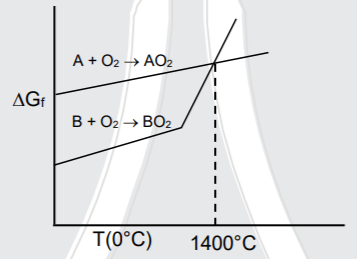It is true that under certain condition, Mg can reduce Al2O3 and Al can reduce MgO? What are those conditions?
To determine the conditions under which magnesium (Mg) can reduce aluminum oxide (Al₂O₃) and aluminum (Al) can reduce magnesium oxide (MgO), we can refer to the Ellingham diagram, which illustrates the stability of metal oxides at varying temperatures.
1. Understanding the Ellingham Diagram:
- The Ellingham diagram plots the Gibbs free energy change (ΔG) for the formation of oxides as a function of temperature. The lower the ΔG, the more stable the oxide.
2. Reduction of Al₂O₃ by Mg:
- Magnesium can reduce aluminum oxide (Al₂O₃) under specific conditions. According to the Ellingham diagram, this occurs when the temperature is below 1350°C. At this temperature, the Gibbs free energy for the reaction of Mg with Al₂O₃ becomes favorable, allowing Mg to act as a reducing agent.
3. Reduction of MgO by Al:
- Conversely, aluminum can reduce magnesium oxide (MgO) when the temperature is above 1350°C. At elevated temperatures, the Gibbs free energy for the reaction of Al with MgO becomes favorable, enabling Al to reduce MgO.
4. Summary of Conditions:
- Therefore, the conditions are:
- Mg can reduce Al₂O₃ when the temperature is below 1350°C.
- Al can reduce MgO when the temperature is above 1350°C.
- The Ellingham diagram plots the Gibbs free energy change (ΔG) for the formation of oxides as a function of temperature. The lower the ΔG, the more stable the oxide.
- Magnesium can reduce aluminum oxide (Al₂O₃) under specific conditions. According to the Ellingham diagram, this occurs when the temperature is below 1350°C. At this temperature, the Gibbs free energy for the reaction of Mg with Al₂O₃ becomes favorable, allowing Mg to act as a reducing agent.
- Conversely, aluminum can reduce magnesium oxide (MgO) when the temperature is above 1350°C. At elevated temperatures, the Gibbs free energy for the reaction of Al with MgO becomes favorable, enabling Al to reduce MgO.
- Therefore, the conditions are:
- Mg can reduce Al₂O₃ when the temperature is below 1350°C.
- Al can reduce MgO when the temperature is above 1350°C.
Topper's Solved these Questions
- APPENDIX INORGANIC VOLUME 2BOOK - CENGAGE CHEMISTRYCHAPTER - APPENDIX INORGANIC VOLUME 2EXERCISE - Exercises
126 Videos
- APPENDIX INORGANIC VOLUME 2BOOK - CENGAGE CHEMISTRYCHAPTER - APPENDIX INORGANIC VOLUME 2EXERCISE - Short Answer Type
179 Videos
- AMINESBOOK - CENGAGE CHEMISTRYCHAPTER - AMINESEXERCISE - QUESTION BANK
1 Videos
- AROMATIC COMPOUNDS AND ALKYL AND ARYL HALIDES BOOK - CENGAGE CHEMISTRYCHAPTER - AROMATIC COMPOUNDS AND ALKYL AND ARYL HALIDES EXERCISE - Archives Subjective
18 Videos
Similar Questions
Knowledge Check
A can reduce BO2 under which conditions.
 A>1400∘CB<1400∘CC>1200∘C and <1400∘CD<1200∘C
A>1400∘CB<1400∘CC>1200∘C and <1400∘CD<1200∘C
Is it true that under certain conditions, Mg can reduce SiO2, and Si can reduce MgO ?
View SolutionIs it true that certain conditions Mg can reduce SiO2 and Si can reduce MgO? What are those conditions?
View SolutionIt is true that under certain coditions magnesium can reduce SiO2 and silicon can reduce MgO. What are those conditions ?
View SolutionThe under certain conditions magnesium can be reduce SiO2 and silicon can reduce MgO. What are those conditions?
View SolutionAlthough heat is a path function but heat absorbed by the system under certain specific conditions is independent of path. What are those conditions? Explain.
View SolutionAlthough heat is a path function but heat absorbed by the system under certain specific conditions is independent of path. What are those conditions? Explain.
View SolutionAlthough heat is a path function but heat absorbed by the system under certain specific conditions is independent of path. What are those conditions? Explain.
View Solution
